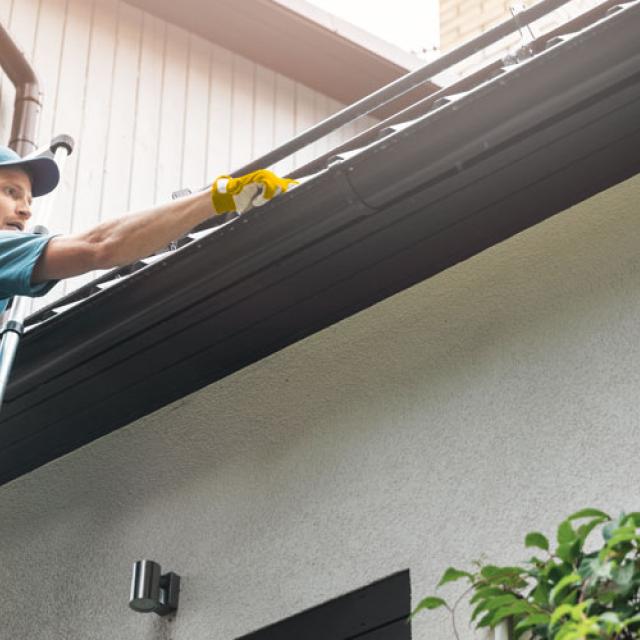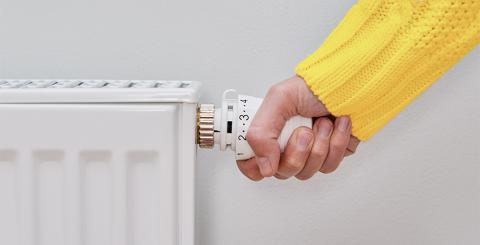Need a spring home maintenance checklist? We’ve got you covered!
Last updated on May 19th, 2020

Everyone agrees this is a great time of year do some home maintenance. Perform this annual rite of spring and you’re practically guaranteed an easy, breezy summer. Obviously home insurance is a necessity, but it’s not enough. You also need to practice prevention to avoid property damage—or at least greatly reduce the risks.
To make sure you don’t forget anything, we asked our prevention experts to create a handy spring home maintenance checklist. It tells you 10 key places to inspect inside and outside your home and gives tips and suggestions on house projects.
It’s not as daunting as it sounds! Just check off the items on the list as you go, and then sit back and enjoy that feeling of accomplishment from a job well done. Ready? Here we go!
1. Check the plumbing under the sinks
There are lots of details to check when it comes to maintaining a home . So spring cleaning needs to be more than just washing windows, floors, and other surfaces (however satisfying that may feel!).
And by more, we mean sticking your head under the sink to check the pipes. Perhaps that’s not the most enjoyable way to pass the time, but some household cleaning products can be corrosive. Pipes should be replaced at the first sign of trouble. To prevent water damage, make a plumbing inspection part of your spring maintenance regimen.
2. Move on to the washing machine hoses
Your washing machine is a work horse. If you want to keep it performing like one, check the condition of the hoses at least once a year. It only takes a minute to look for cracks, blisters, corrosion, and other signs of damage. If you see any, replace the hoses immediately.
Braided stainless steel hoses are more durable and have a lower failure rate than rubber hoses. Actually, a good rule of thumb is to replace rubber hoses every 5 years and steel hoses every 10—no matter what their condition.
Prevention tip: The only sure-fire way to prevent damage is to get in the habit of turning off the shut-off valves behind the washing machine after use.
3. Don’t forget the dishwasher and refrigerators hoses
The dishwasher is always there when you need it, so it deserves some regular TLC. Why not make that part of your spring maintenance plan? Bend over to examine the drain hose that’s under or behind the dishwasher and the one under the kitchen sink where the dishwasher connects. You’ll be able to spot minor leaks that could lead to a mould and mildew problem over time.
For refrigerators with water lines, it’s important to check the supply hose and make sure it’s in good condition. This will help prevent unpleasant surprises and water damage. If a plastic hose is supplied by the manufacturer, we recommend replacing it with a high-quality braided steel hose.
4. Inspect the water heater
Your water heater is a potential cause of major water damage and expensive home repairs. In addition to having home insurance that covers water damage, you should routinely inspect the water heater and replace it every 10 years. Drain it occasionally to flush the sediment from the bottom of the tank and prevent scaling on the heating elements.
Warning signs: If you notice your hot water doesn’t hold up or isn’t as hot as it should be, that may be a sign that the water heater is on its last legs. Visible rust spots around the bottom of the tank? Careful: It may be cracked and have a slow and steady leak.
5. Look for leaks
Preventing water damag should be a priority, as it’s the most common cause of property damage. Checking for leaks is an important step in prevention and in your spring home maintenance plan. First make sure you and all your family members know where the main water shutoff valve is. When it comes to water in your home, the faster you respond, the less damage there will be.
Prevention tip: Consider installing a leak detection system, which triggers an alarm and automatically shuts off the main water valve when a leak occurs. Promutuel Insurance offers big discounts on home insurance when you install a detection system because they’re so effective at preventing water damage.
6. Check the caulk around plumbing fixtures
A clean caulking job around the tub, shower, and sink keeps water from going where you don’t want it to go. Sealants lose elasticity over time and start to crack, flake, and even rot—do nothing and you could be in for a nasty surprise! Everyday use of a shower that isn’t waterproof can cause major issues. A periodic inspection is a necessity, so why not do it every spring?
7. Clean and inspect the backwater valve
A backwater valve helps prevent sewage in an overloaded municipal sewer line from backing up into your basement. Routine maintenance will keep it working the way it should. Simply remove any debris that could clog the valve.
Pro tip: Don’t forget to wear gloves!
8. Visually inspect the foundation
We recommend checking the condition of your foundation from inside (where possible) and outside your home. Be on the lookout for holes, cracks, crevices, or visible shifting. Other red flags include damage caused from moisture in concrete foundation walls and slab floors or water seeping in at the base of the walls.
9. Clean the gutters
It’s a task we often overlook, put off, or forget entirely, but gutter cleaning is an important part of any spring cleaning routine. Slip on some gloves to remove leaves and debris by hand and then use a garden hose to clean everything out, including the downspout. If you’re using a ladder, take the necessary safety precautions.
10. Last but not least, clear the downspouts
In the process of cleaning your gutters, if you notice a trickle of water running down the downspout, it may be clogged. Grab the garden hose, insert it into the downspout from the bottom up, turn the nozzle upward, and then turn the water on. This should dislodge any clogs and allow the water to flow freely.
You’ve done everything on your spring home maintenance checklist. Nice work! This list is by no means complete, but it covers the most important things you can do to prevent damage and determine which house repairs to prioritize. Now, why not move the spring cleaning outside and get your yard ready for summer!
If you’d like more information on home insurance, give us a call. Our prevention experts are THERE with plenty of good advice.



